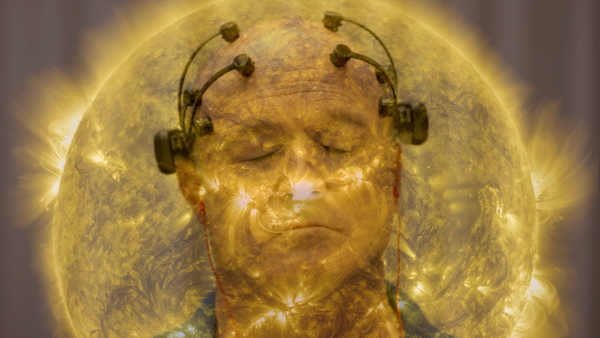
Theo Anthony’s heady second documentary is inspired by the idea we can’t always trust what we see including our own eyes. In a fascinating opening shot, an unnamed subject manages to photograph his own optic nerve. However, according to a caption, the brain actually receives no visual information here; it’s a blind spot, albeit one we aren’t aware of as the brain constantly invents a world to compensate for it.
To Anthony, it’s worth investigating just how subjective reality is and the forces that shape our perception of it. The film cuts back and forth between multiple people, most of whom have image-recording in common: the CEO of one of the largest manufacturers of body cameras used by police officers, Axon; a Baltimore Police Department training class for body cams; and another executive behind a plane that secretly surveilled Black neighborhoods in the Monumental City in 2016.
Each story line is fascinating in its own way, especially a tour of the corporate headquarters of Axon, where much is hidden from view, despite transparency supposedly being a guiding mantra. From time to time, there are segues to real-life historical figures such as French astronomer Jules Janssen, who invented a predecessor of the movie camera inspired by the semi-automatic Gatling gun, which went on to influence the ballistics of the period. Anthony draws connections between cameras, weapons, and policing, revealing how this unholy trilogy has evolved together.
In his debut 2017 feature, Rat Film, Anthony similarly jumped between narratives to paint a multifaceted portrait of the titular rodent, whose existence in Baltimore was inexorably intertwined with sections of the city’s decay. He cut instinctively between his subjects in ways that often reveal a larger point. In All Light, Everywhere, one scene involves how pigeons were fitted with cameras by the German military circa the early 1900s so they could be used as spies, followed by a transition to the police body cam class, the seeming implication being that both subjects aren’t so different (indeed, both are tethered to cameras by which they are the eyes of the state).
The filmmakers take a highly critical stance toward body cameras, especially the way in which Axon has melded its product into an officer’s work routine. Because all the body cam footage is recorded from a point of view in which the officer remains largely out of frame, a narrative of off-screen events can be invented after the fact. However, the case against the technology is presented in a relatively neutral manner, with recordings of Axon’s spokesman and footage of Anthony’s own troubleshooting of the manufacturer’s suite of online tools.
Much of the second half centers on the idea that the mere presence of a camera changes how people behave. A public meeting takes place between the executive behind the surveillance plane, which had been grounded since the news of its existence broke, and Baltimore residents, whom he tries to bring to his side to get the aircraft back in use. The discussion quickly devolves, but the ensuing chaos feels brilliantly choreographed as attendees make cogent points about whether the surrendering of privacy is worth a possible decline in crime, given that all of the data collected by the surveillance plane would belong to a private company, the intentions of which are unknown. Someone speculates the fiery tone of the debate has something to do the presence of the filmmakers, though another possibility is that those who are traditionally the object of the lens at last are face-to-face with the power behind the camera.
Through all of the themes it juggles, the film never loses sight of the bigger picture—specifically, where does decades of information collected by weaponized cameras go and what it might lead to? Some of the possibilities are chilling and highly logical. At least the last leg of this cinematic essay goes in a wholly unexpected direction that is decidedly more upbeat than everything that came before, possibly because it hints at that no matter how powerful cameras are, they still fail to capture the full range of human potential, which is always expanding past the edges of the frame.
All Light, Everywhere is an intriguing examination of what the lens sees and everything it misses.
















Leave A Comment